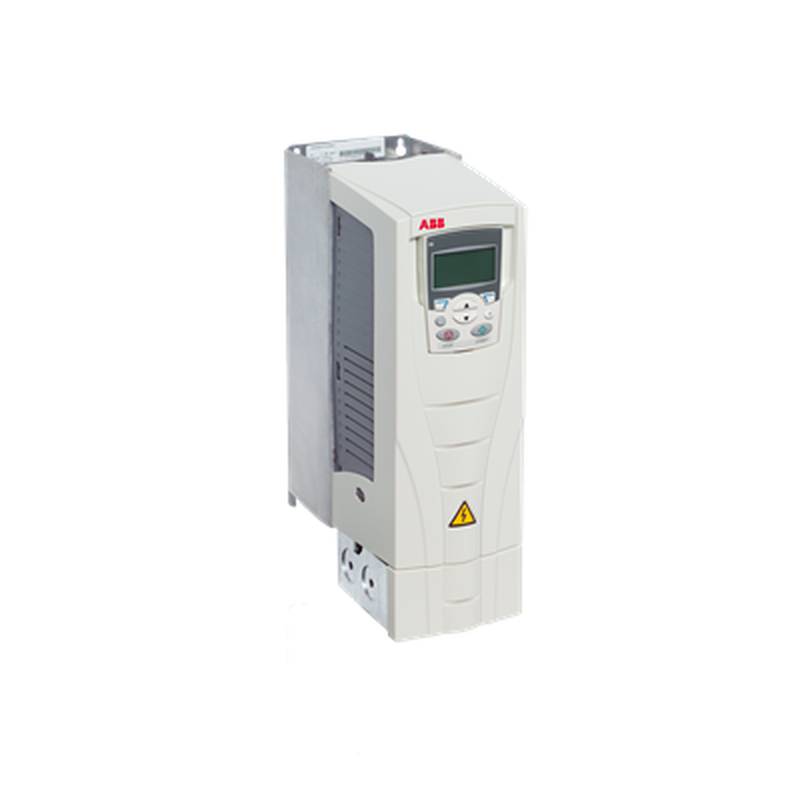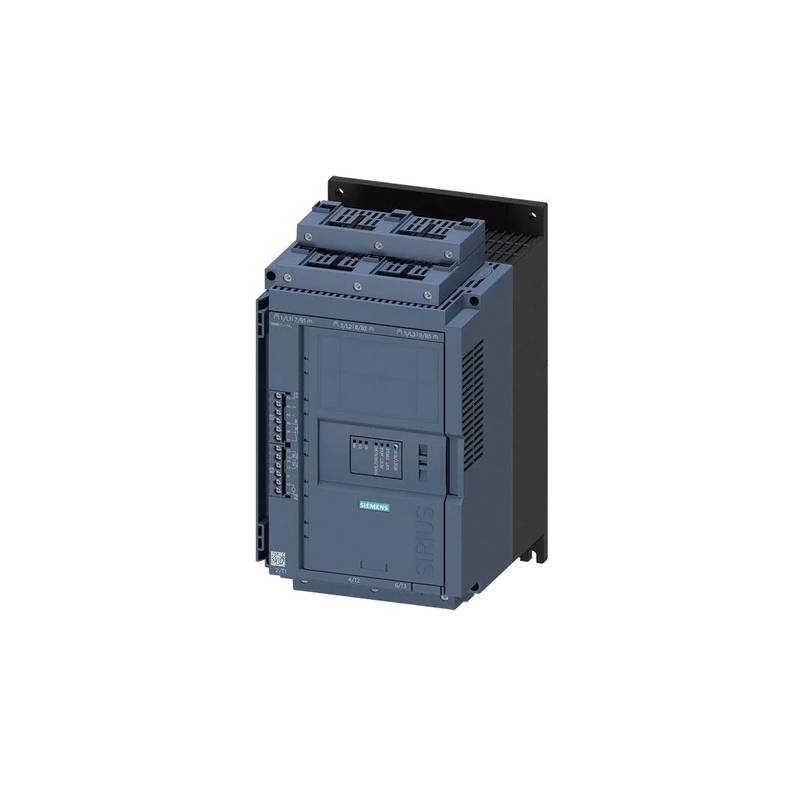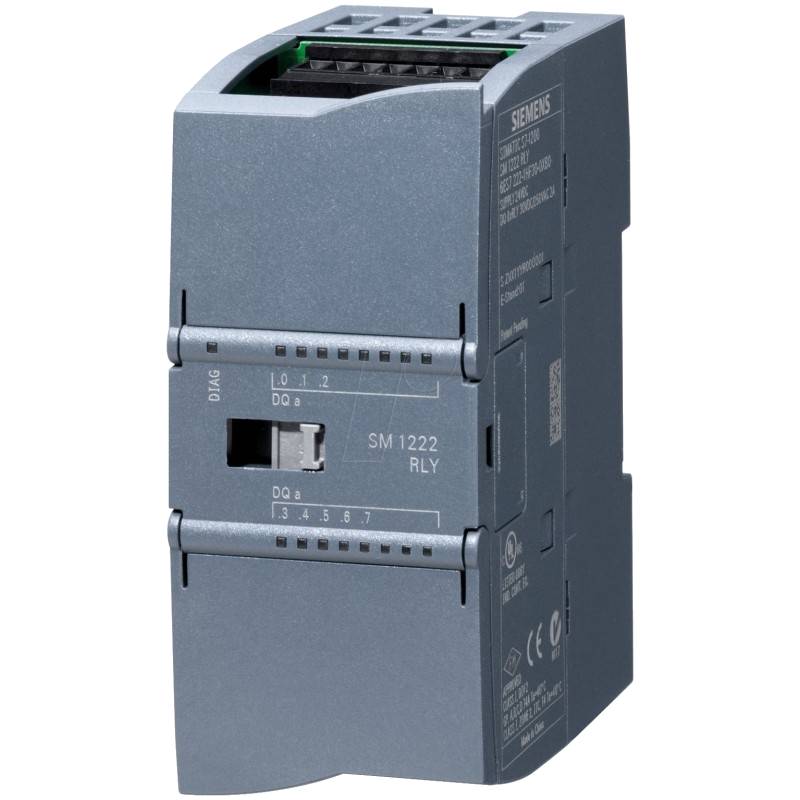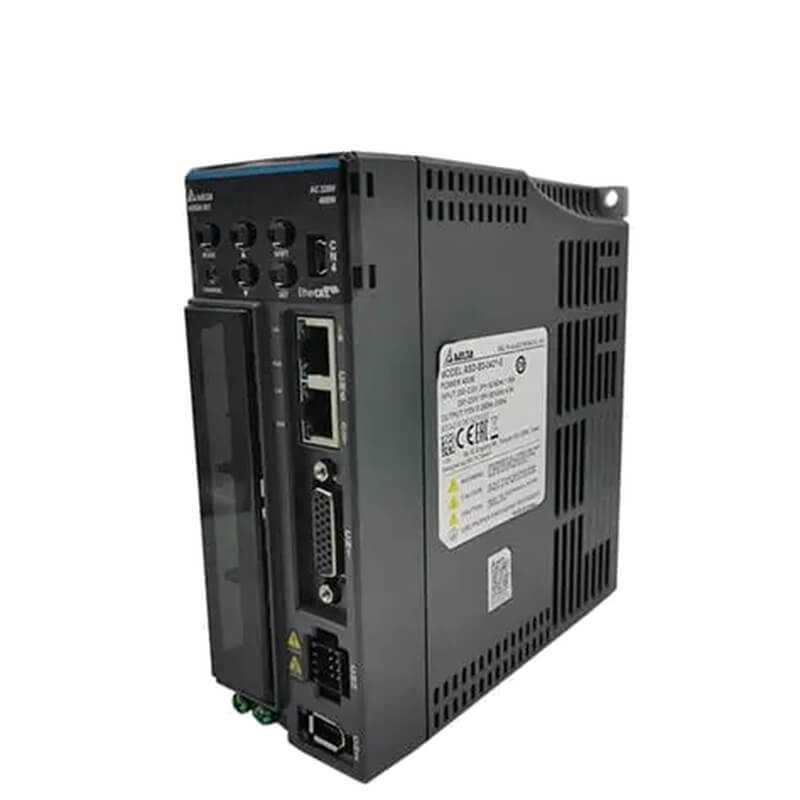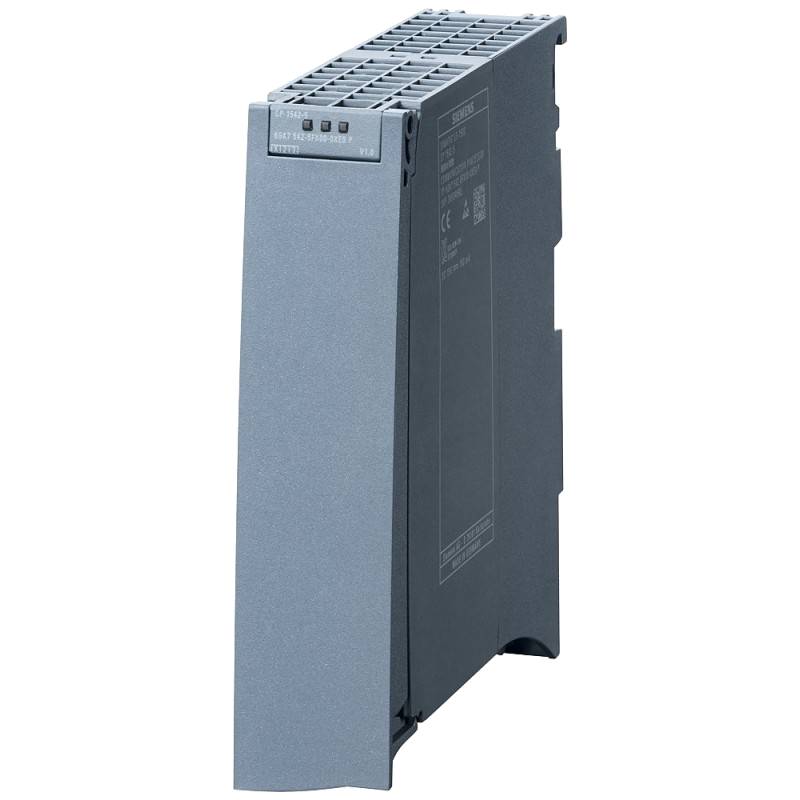
The ABB ACS510-01-060A-4 is a robust, user-friendly universal frequency converter drive designed for a wide spectrum of industrial applications, delivering precise motor control and significant energy savings. This drive boasts a power rating of 30 kW (40 HP) and operates on a 400-415V, 3-phase power supply, featuring an IP21 enclosure for protection against dust and water ingress. Its compact design, integrated filtering, and straightforward commissioning process make it an ideal solution for original equipment manufacturers (OEMs) and system integrators seeking reliable performance and operational efficiency. The ACS510 series is renowned for its simplicity, offering intuitive controls and a flexible programming interface that facilitates rapid deployment across various motor-driven processes.
Product Specifications
| Feature | Specification |
| :------------------------ | :------------------------------------------ |
| Model Number | ACS510-01-060A-4 |
| Rated Output Power | 30 kW / 40 HP |
| Input Voltage | 400-415V, 3-phase |
| Output Voltage | 0 to input voltage |
| Output Frequency | 0 to 500 Hz |
| Enclosure Type | IP21 |
| Ambient Temperature Range | -10°C to +50°C (derating above +40°C) |
| Dimensions (H x W x D) | 504 mm x 220 mm x 241 mm |
| Weight | 16 kg |
| Braking Unit | Integrated (chopper) for 30 kW and above |
| Harmonic Distortion | Integrated harmonic filter |
| Control Method | V/f, Flux Vector Control |
Core Features & Market Positioning
The ABB ACS510-01-060A-4 distinguishes itself through its "universal" nature, offering unparalleled versatility for various motor types and applications without requiring extensive parameterization. Its integrated harmonic filter significantly reduces electromagnetic interference (EMI) and improves power quality, a crucial advantage in sensitive industrial environments. This drive is positioned as a cost-effective, high-performance solution that balances advanced control capabilities with ease of use, making it a preferred choice for applications where reliability, energy efficiency, and simple integration are paramount. The ACS510 series consistently receives positive market feedback for its robust construction and dependable operation, even under demanding conditions.
Key Application Scenarios
This frequency converter drive excels in a multitude of industrial sectors. It is a common choice for pump and fan applications, where variable speed control can yield substantial energy savings by matching motor output to system demand, seen in HVAC systems and water treatment plants. Its robust performance also makes it suitable for conveyor systems, mixers, crushers, and general machinery, providing smooth acceleration and deceleration, thereby reducing mechanical stress on equipment. The ACS510-01-060A-4 is particularly well-suited for OEMs building machinery that requires precise speed regulation and energy optimization.
Practical System Integration Guidance
Integrating the ABB ACS510-01-060A-4 into existing systems is streamlined due to its user-friendly interface and comprehensive documentation. The drive supports standard fieldbus protocols, enabling seamless communication with Programmable Logic Controllers (PLCs) and Supervisory Control and Data Acquisition (SCADA) systems. Wiring is straightforward, with clear terminal designations for power, control, and communication signals. Commissioning is facilitated by the intuitive control panel and the availability of pre-programmed macros for common applications, significantly reducing setup time. For advanced configurations, ABB's Drive Composer software provides a graphical interface for parameter setting, monitoring, and troubleshooting.
Operation and Risk Mitigation
Safe and efficient operation of the ABB ACS510-01-060A-4 is ensured through its built-in safety features and diagnostic capabilities. It includes overcurrent, overvoltage, undervoltage, and overheating protection to safeguard the drive and connected motor. The integrated braking unit provides controlled deceleration and can dissipate excess energy during braking, preventing overvoltage. Critical error codes are clearly displayed on the control panel, with corresponding explanations available in the user manual to guide troubleshooting. Regular maintenance, including keeping ventilation paths clear and checking electrical connections, is recommended to ensure long-term reliability and prevent unexpected shutdowns.
Scalability & Long-Term Value
The ACS510 series offers a degree of scalability through its compatibility with ABB's broader automation portfolio and its ability to integrate with Industrial Internet of Things (IIoT) platforms via optional communication modules. This allows for remote monitoring, predictive maintenance, and performance optimization, aligning with Industry 4.0 initiatives. While the ACS510 is a mature product, its robust design and consistent performance provide long-term value, minimizing downtime and operational costs. For applications requiring more advanced features or higher power ratings, ABB offers a comprehensive range of drives that can be integrated seamlessly with the ACS510, providing a clear upgrade path.
Frequently Asked Questions
1. What are the primary benefits of using the ABB ACS510-01-060A-4?
The ACS510-01-060A-4 offers significant energy savings by precisely controlling motor speed according to load requirements, reducing overall power consumption compared to fixed-speed operation. Its universal design simplifies selection and installation, as it accommodates various motor types and applications with minimal configuration adjustments. The drive also enhances equipment longevity by providing soft starting and stopping, which reduces mechanical stress on motors and driven machinery.
This frequency converter drive features an integrated harmonic filter, which is crucial for maintaining high power quality and minimizing electromagnetic interference in sensitive electrical systems. This protection is vital for ensuring the reliable operation of other connected equipment and adhering to power quality standards. Furthermore, its robust IP21 enclosure offers protection against dust and water, making it suitable for demanding industrial environments where incidental moisture or dust may be present.
The user-friendly interface and straightforward commissioning process are key advantages, allowing for quick setup and integration into existing systems. This reduces installation time and labor costs, making it an economically attractive option for both new installations and retrofits. The drive's comprehensive protection features also contribute to operational safety and reduced risk of equipment damage.
2. How do I set up basic parameters on the ABB ACS510-01-060A-4 for a pump application?
For a pump application, begin by setting the motor data, including rated power, voltage, current, and frequency, which can typically be found on the motor's nameplate. Correctly inputting these values ensures optimal motor performance and protection within the drive's capabilities. Access the motor data parameters through the drive's control panel or via the Drive Composer software for a more detailed overview.
Next, configure the application-specific parameters for pumps and fans, such as minimum and maximum speed limits, acceleration and deceleration times, and the desired control mode (e.g., V/f control or flux vector control). These settings allow the drive to operate efficiently within the system's operating range and prevent sudden starts or stops that could damage the pump. Adjusting these parameters can also fine-tune performance for energy efficiency.
Finally, verify the start/stop control method and ensure any external control signals (e.g., from a pressure sensor or level switch) are correctly wired and configured in the drive's input settings. This ensures the pump starts and stops as intended based on system demand, maximizing operational efficiency and responding appropriately to changing conditions. Always consult the product manual for specific parameter numbers and sequences.
3. What are common fault codes for the ABB ACS510-01-060A-4 and how can I troubleshoot them?
A common fault is the "Overcurrent" fault (F001), which typically indicates that the motor is drawing more current than the drive can safely supply. This can be caused by a short circuit, a direct short from phase to ground, or an excessively high load. Troubleshooting involves checking motor windings for shorts, ensuring the load is not too high for the drive's rating, and inspecting all power cabling for damage or loose connections.
Another frequent issue is the "Overvoltage" fault (F002), often occurring during deceleration when the motor acts as a generator, feeding power back into the drive. If the braking chopper and resistor are undersized or absent, the DC bus voltage can rise too high. Solutions include increasing deceleration time, ensuring the integrated braking unit is enabled and properly configured, or installing a larger external braking resistor if necessary.
The "Overheating" fault (F010) signifies that the drive's internal temperature has exceeded safe limits, often due to insufficient cooling, high ambient temperature, or dust accumulation in the heatsink. To resolve this, ensure the drive is installed in a well-ventilated area, check that cooling fans are operational, and clean the heatsink regularly. If operating at high ambient temperatures, consider derating the drive or improving ventilation.
4. Can the ABB ACS510-01-060A-4 be used with different types of electric motors?
Yes, the ABB ACS510-01-060A-4 is a universal frequency converter, meaning it is designed to control a wide variety of AC induction motors, including standard squirrel-cage motors. Its flexible control modes, such as V/f and Flux Vector Control, allow it to adapt to the specific characteristics of different motor types for optimal performance. This versatility makes it suitable for diverse industrial applications without requiring specialized drives for each motor.
The drive's parameter settings can be adjusted to match the motor's electrical characteristics, ensuring efficient operation and accurate speed regulation. While it primarily supports standard induction motors, some configurations might allow for compatibility with other AC motor types, provided they fall within the drive's voltage and frequency operating ranges. Always verify motor compatibility with the drive's specifications before installation.
For advanced applications requiring precise torque control or dynamic response, the Flux Vector Control mode offers superior performance with induction motors. This mode utilizes feedback from the motor's magnetic flux to achieve more accurate speed and torque regulation, similar to that of DC or synchronous motors. This enhanced control capability makes the ACS510-01-060A-4 highly adaptable to demanding applications.
5. What is the purpose of the integrated harmonic filter in the ACS510-01-060A-4?
The integrated harmonic filter significantly reduces the harmonic distortion generated by the variable frequency drive's power electronics. Harmonics are unwanted frequencies that can cause overheating, reduced efficiency, and interference with sensitive electronic equipment in the power system. By mitigating these harmonics, the filter helps maintain cleaner power quality for the entire installation.
This filtering capability ensures that the ACS510-01-060A-4 complies with various power quality standards, such as EN 61000-3-12, which limits harmonic emissions. Compliance is crucial for installations connected to public low-voltage grids, preventing disruptions to other consumers and avoiding potential penalties or regulatory issues. It contributes to a more stable and reliable power supply network.
Furthermore, by reducing harmonic currents, the filter can lead to improved overall system efficiency and reduced energy losses in the power supply infrastructure. This translates to lower operating costs and a reduced environmental footprint, aligning with sustainability goals. The integrated nature of the filter also simplifies installation by eliminating the need for external harmonic filters in many applications.
6. How does the ACS510-01-060A-4 contribute to energy savings in industrial applications?
The primary mechanism for energy saving with the ACS510-01-060A-4 is its ability to precisely control motor speed. By adjusting the motor's speed to match the actual process demand, instead of running at full speed and using mechanical throttling or bypass systems, significant energy consumption reductions are achieved. This is particularly effective in variable torque applications like pumps and fans.
For example, in a centrifugal pump application, reducing the motor speed by just 20% can decrease energy consumption by up to 50%. The ACS510-01-060A-4 enables this level of precise speed control, allowing users to fine-tune operations for maximum efficiency. The drive’s V/f control or Flux Vector Control modes ensure that the motor operates at optimal efficiency points across its speed range.
Additionally, features like an energy optimizer function can further enhance savings by fine-tuning the voltage/frequency ratio for maximum motor efficiency at different operating points. The drive also offers features like automatic start/stop and sleep mode functionalities, which further reduce energy consumption during periods of low or no demand, contributing to substantial operational cost reductions over time.
7. What are the environmental operating conditions for the ABB ACS510-01-060A-4?
The ABB ACS510-01-060A-4 is designed to operate within an ambient temperature range of -10°C to +50°C. However, it is important to note that derating of the drive's output current capacity is required when operating above +40°C. Specific derating factors are provided in the product documentation to ensure safe and reliable operation at elevated temperatures.
Regarding humidity, the drive is typically designed for non-condensing conditions. Exposure to high humidity or moisture can lead to internal damage and electrical faults. Therefore, it is crucial to install the drive in an environment where moisture levels are controlled and condensation is avoided. Proper ventilation is also key to managing internal temperature and humidity.
The IP21 enclosure rating provides protection against solid objects greater than 12.5 mm (e.g., tools, wires) and vertically falling water droplets. This rating signifies that the drive is suitable for indoor use in industrial environments where some level of dust and incidental water exposure might occur, but it is not designed for direct exposure to rain, high-pressure washing, or submersion.
8. How does the braking unit integrated into the ACS510-01-060A-4 function?
The integrated braking unit, also known as a chopper, is designed to dissipate excess energy generated when the motor is decelerating or operating as a generator. During these modes, the motor feeds power back into the drive's DC bus, which can cause the DC bus voltage to rise. The braking chopper activates to discharge this excess energy through an external braking resistor, preventing overvoltage faults.
This functionality is crucial for applications requiring rapid deceleration or frequent braking cycles, such as those involving hoists, elevators, or conveyors carrying heavy loads. By actively managing the DC bus voltage, the integrated braking system ensures smooth and controlled stopping of the motor, protecting both the drive and the driven equipment from potential damage caused by voltage spikes.
The ACS510-01-060A-4 models rated at 30 kW and above typically include this integrated braking chopper as a standard feature. For smaller models or applications with very high braking energy requirements, an external braking resistor and possibly a separate braking unit might be necessary. Proper sizing and configuration of the braking system are essential for optimal performance and safety.
9. What communication protocols does the ABB ACS510-01-060A-4 support for integration with automation systems?
The ABB ACS510-01-060A-4 supports standard industrial fieldbus protocols, allowing it to be easily integrated into modern automation systems. Optional communication modules can be installed to enable connectivity via protocols such as Modbus RTU, PROFIBUS DP, DeviceNet, and CANopen. This flexibility ensures compatibility with a wide range of PLCs and SCADA systems.
By utilizing these fieldbus protocols, users can achieve seamless communication for remote control, monitoring, and diagnostics of the drive. This includes the ability to read status information, change setpoints, monitor performance parameters, and diagnose faults remotely, thereby improving operational efficiency and enabling predictive maintenance strategies.
The inclusion of these communication options makes the ACS510-01-060A-4 a versatile component in integrated automation solutions. Whether it's a simple start/stop command or complex data exchange for process optimization, the drive's communication capabilities facilitate robust and efficient system integration.
10. Is the ABB ACS510-01-060A-4 suitable for use in hazardous or explosive environments?
No, the standard ABB ACS510-01-060A-4 is not designed or certified for use in hazardous or explosive environments. Its IP21 enclosure rating offers protection against solid objects and falling water but does not provide the necessary sealing or safety features required for areas classified as hazardous (e.g., Zone 1, Zone 2, Zone 21, Zone 22) where flammable gases, vapors, or dust may be present.
Using standard industrial drives in such environments can pose a significant safety risk, as sparks or excessive heat generated by the drive could ignite the surrounding atmosphere, leading to explosions or fires. Specialised drives with appropriate ATEX or IECEx certifications are required for these demanding applications to ensure compliance with safety regulations.
For applications in potentially explosive atmospheres, ABB offers a range of drives specifically designed and certified to meet the stringent safety requirements of these environments. It is crucial to consult with ABB or a qualified expert to select the correct drive certified for the specific hazardous area classification and operational conditions.














